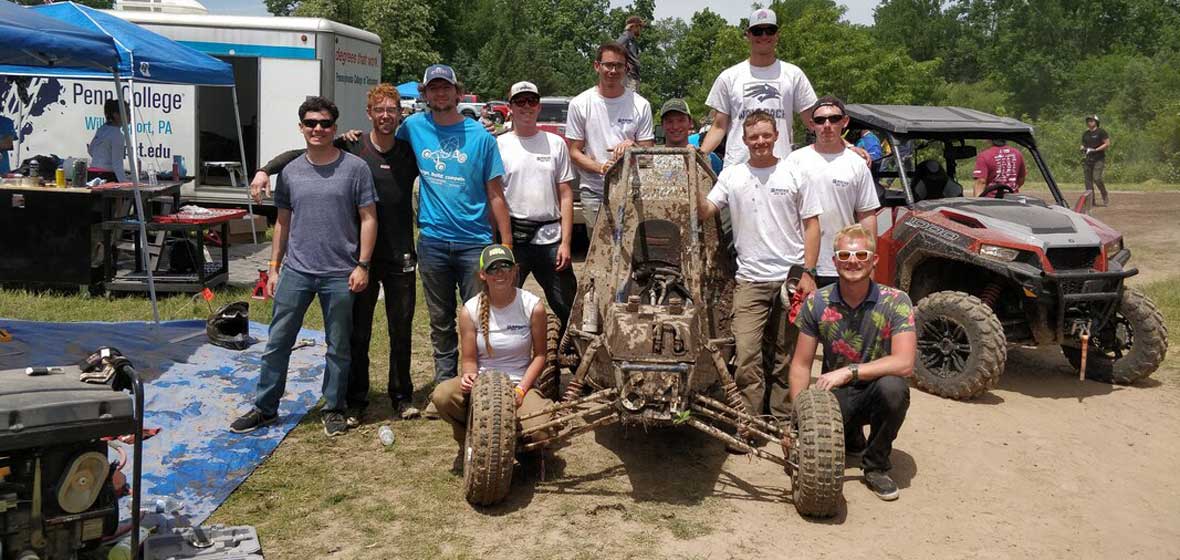From the Society of Automotive Engineers, Baja SAE, a program in which engineering students build a single-seat, all-terrain sporting vehicle prototype for recreational use, drove its way to the University of Nevada, Reno campus. Wolf Pack Racing at the University of Nevada, Reno, had a goal to attend the yearly Baja SAE competition in Rochester, New York, and participate in four-hour endurance race.
The endurance event took place on Hogback Hill Motocross Track. The four-hour race on a mile-long course has obstacles for racers like logs, tires and jumps. The team began the race in 46th place and passed enough teams to start the hour at 37th until a flat tire challenged the vehicle. At the end of the four hours, Wolf Pack Racing recorded 18 laps, placing them in 18th out of the single event teams and 53rd overall. The winning team recorded 52 laps.
"I've been really impressed to see how the students, all on their own, came together as a team to put together a complete competition vehicle from scratch over the past six months or so," said Floris van Breugel, assistant professor of mechanical engineering. "This required finding sponsors, making the designs, sourcing materials, testing, fabricating or outsourcing [fabrication], all on a pretty tight schedule."
As they prepared for the race, the team's top priority was to make sure the car is built to withstand four hours of consistent punishment. Overall, the team set out to design and build a prototype of an all-weather, rugged, single-seat, off-roading recreational vehicle that appeals to off-road enthusiasts. The goals the team hoped to accomplish for this year included passing technical inspection on the first attempt, competing in all events, improve upon last year's design, weigh under 450 pounds and develop technical and personal skills for the future engineers.
"When choosing materials or designs, we need to make sure it is reliable and won't break after the first lap," said Jack Gall, a student member of the team. "There's a lot of simulation and analysis of components, as well as on-track testing to validate the parts."
When it comes to the building process, team members described it as "long and complicated." Gall says that hundreds of manufacturing drawings were made and for many of the custom parts, a custom jig, or frame, was necessary. Many students put in thirty hours a week in the spring semester while also balancing full-time student schedules.
For this year's event, which occurred from June 6-9, the team participated in static, dynamic and endurance events. Static events include cost reporting and design and sales presentations. Dynamic events include acceleration tests, hill climbs, maneuverability and suspension testing.
"The biggest challenge this year was manufacturing a custom designed gear case," Gall said. "The physics department came through for us and did a wonderful job. Working with other departments in the University allows us to perform our best." The team was also able to use part of the machine shop on campus, along with the student collaboration room.
Getting sponsors is a challenging process for any team, but as the list of achievements grow, so does the sponsorship base. Sponsors also can share expertise, materials and resources for the students.
"We are forever grateful to our sponsors and without them, our team would not exist," Gall said. "Being able to consistently attend the competition for the past two years has allowed us to give back to the sponsors with things like promotions and results. Building a relationship on a professional level also opens up opportunities for internships that can benefit both sponsors and students."
Goals for the future drive members to succeed in automotive engineering
Member Kyle Mitlyng says that one benefit of being a part of this team is the exposure they get to industry professionals, and how being in the club can give them a technical edge that most traditional engineering students don't always get to participate in.
"I plan on doing my automotive engineering masters in Germany or going to work with the company that I am interning with currently, as an automotive test engineering at Nevada Automotive Test Center," Mitlyng said. "There are a lot of opportunities so I don't want to limit myself; so, I will apply to a handful of automotive engineering firms."
For Henry Rendler, joining the team has allowed him to attend SAE International Baja competitions in Oregon and this year's in New York. It also allowed him to work with the President's Office at the University to help open the newly renovated Palmer Engineering as well as help break ground for the new William Pennington Engineering Building.
For this year's competition, he helped design and manufacture different parts of the car and assisted in welding said parts.
"Many employers recognize that being a member of a collegiate design team like SAE Baja is a full-time commitment," Rendler said.
The team's goal for next year is to improve their performance in static competitions, and modify some of the steering issues they faced.











